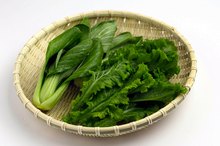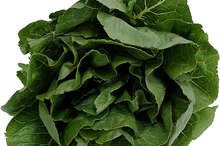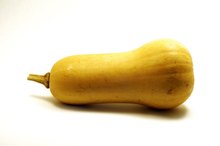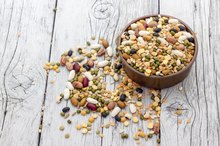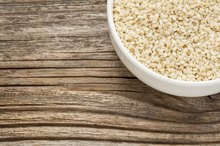What does fact checked mean?
At Healthfully, we strive to deliver objective content that is accurate and up-to-date. Our team periodically reviews articles in order to ensure content quality. The sources cited below consist of evidence from peer-reviewed journals, prominent medical organizations, academic associations, and government data.
- Harvard School of Public Health: Vitamin C
- MayoClinic.com; Healthy Diet: End the Guesswork with These Nutrition Guidelines; February 2011
- Harvard School of Public Health; Vitamins
The information contained on this site is for informational purposes only, and should not be used as a substitute for the advice of a professional health care provider. Please check with the appropriate physician regarding health questions and concerns. Although we strive to deliver accurate and up-to-date information, no guarantee to that effect is made.
Nutrients in Fresh Vs. Dried Parsley
You may overlook parsley as a healthy vegetable because you likely consider it a a garnish rather than a nutrient-dense food. According to Michael T. Murray, Joseph Pizzorno and Lara Pizzorno, authors of "The Encyclopedia of Healing Foods," people have been eating parsley as a vegetable for more than 2,500 years, and have used it for medicinal purposes for even longer 2. Both dried and fresh parsley have a valuable place in your diet, although they contain different nutrients.
Fiber
Eating more parsley may help you consume more fiber. According to Michael T. Murray, Joseph Pizzorno and Lara Pizzorno, authors of "The Encyclopedia of Healing Foods," parsley is a good source of dietary fiber that is also low in calories and rich in many different nutrients 2. You will get more fiber benefits from fresh parsley because you can eat more of it at a time than dried parsley, which has a much stronger taste. Including 1 cup of fresh parsley in a tossed salad will add 2 g of fiber. You will get 0.4 g of fiber from 1 tablespoon of dried parsley. Getting more fiber may reduce bowel problems like constipation, and may also lower your risk of heart disease and colon cancer.
- Eating more parsley may help you consume more fiber.
- You will get more fiber benefits from fresh parsley because you can eat more of it at a time than dried parsley, which has a much stronger taste.
Vitamin C
Nutritional Value of Cooked Cabbage
Learn More
Another nutrient present in high doses in parsley is vitamin C. Both fresh and dried parsley contain a healthy dose of this important vitamin. Getting sufficient amounts of vitamin C from your food may help treat and control infections. Vitamin C is also essential for the health of your bones, muscles and blood vessels. A 1-tablespoon serving of fresh parsley contains 5.1 mg of vitamin C, while 1 tablespoon of dried parsley has 2 mg.
- Another nutrient present in high doses in parsley is vitamin C. Both fresh and dried parsley contain a healthy dose of this important vitamin.
Vitamin A
Vitamin A is another nutrient in parsley, both fresh and dried. Fresh parsley contains more vitamin A per 1-tablespoon serving, with 320 IU. The same serving of dried parsley contains just 31 IU. Vitamin A is most often associated with eyesight, but it also supports the health of your white blood cells and the production of all other cells in your body.
- Vitamin A is another nutrient in parsley, both fresh and dried.
- Fresh parsley contains more vitamin A per 1-tablespoon serving, with 320 IU.
Other Nutrients
Fresh Dates vs. Dried Dates
Learn More
Both fresh and dried parsley contain small amounts of many more vitamins and minerals. A 1-tablespoon serving of fresh parsley has 5 mg of calcium, and the same serving of dried has 18 mg. Calcium is important for bones and teeth. Fresh parsley also contains 21 mg of potassium, 6 mcg of folate and 62.3 mg of vitamin K in just 1 tablespoon. The same amount of dried parsley contains 43 mg of potassium, 3 mcg of folate and 21.8 mg of vitamin K. You need potassium for muscle and heart health and vitamin K for proper clotting of your blood. Folate may help reduce birth defect risks, if you are pregnant.
- Both fresh and dried parsley contain small amounts of many more vitamins and minerals.
- The same amount of dried parsley contains 43 mg of potassium, 3 mcg of folate and 21.8 mg of vitamin K. You need potassium for muscle and heart health and vitamin K for proper clotting of your blood.
Related Articles
References
- USDA Nutrient Database; Nutrient Data Laboratory
- "The Encyclopedia of Healing Foods"; Michael T. Murray, Joseph Pizzorno and Lara Pizzorno; 2005
- Harvard School of Public Health; Vitamins
- American Heart Association; Potassium; May 2010
- Therapeutic Research Center - Natural Medicines. Parsley.
- Kaefer, Christine M., and John A. Milner. “The Role of Herbs and Spices in Cancer Prevention.” The Journal of Nutritional Biochemistry 19.6 (2008): 347–361.
- Alyami, Fahad & Rabah, Danny. Effect of drinking parsley leaf tea on urinary composition and urinary stones′ risk factors. Saudi journal of kidney diseases and transplantation: an official publication of the Saudi Center for Organ Transplantation, Saudi Arabia. 22. 511-4.
Writer Bio
Sara Ipatenco has taught writing, health and nutrition. She started writing in 2007 and has been published in Teaching Tolerance magazine. Ipatenco holds a bachelor's degree and a master's degree in education, both from the University of Denver.
